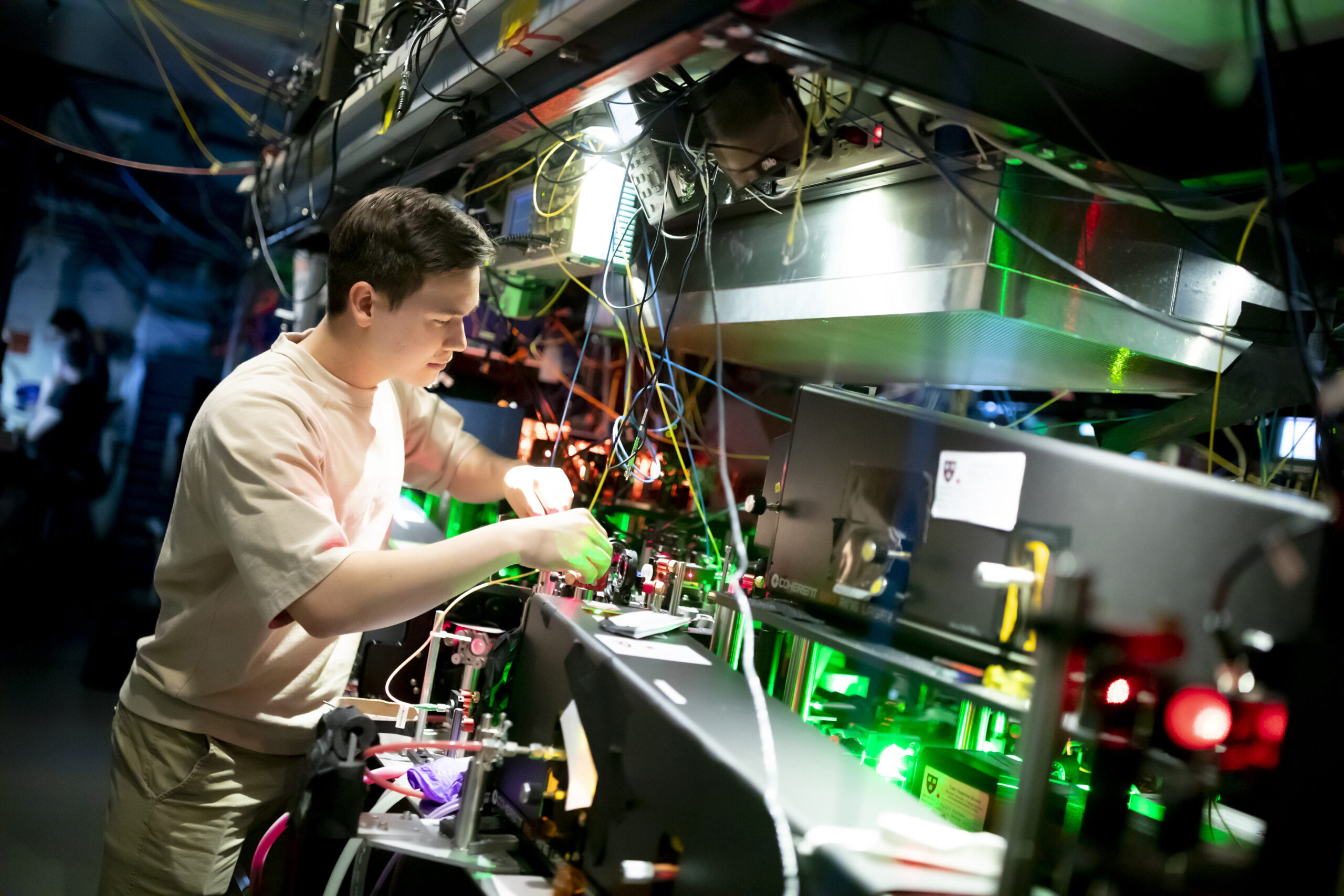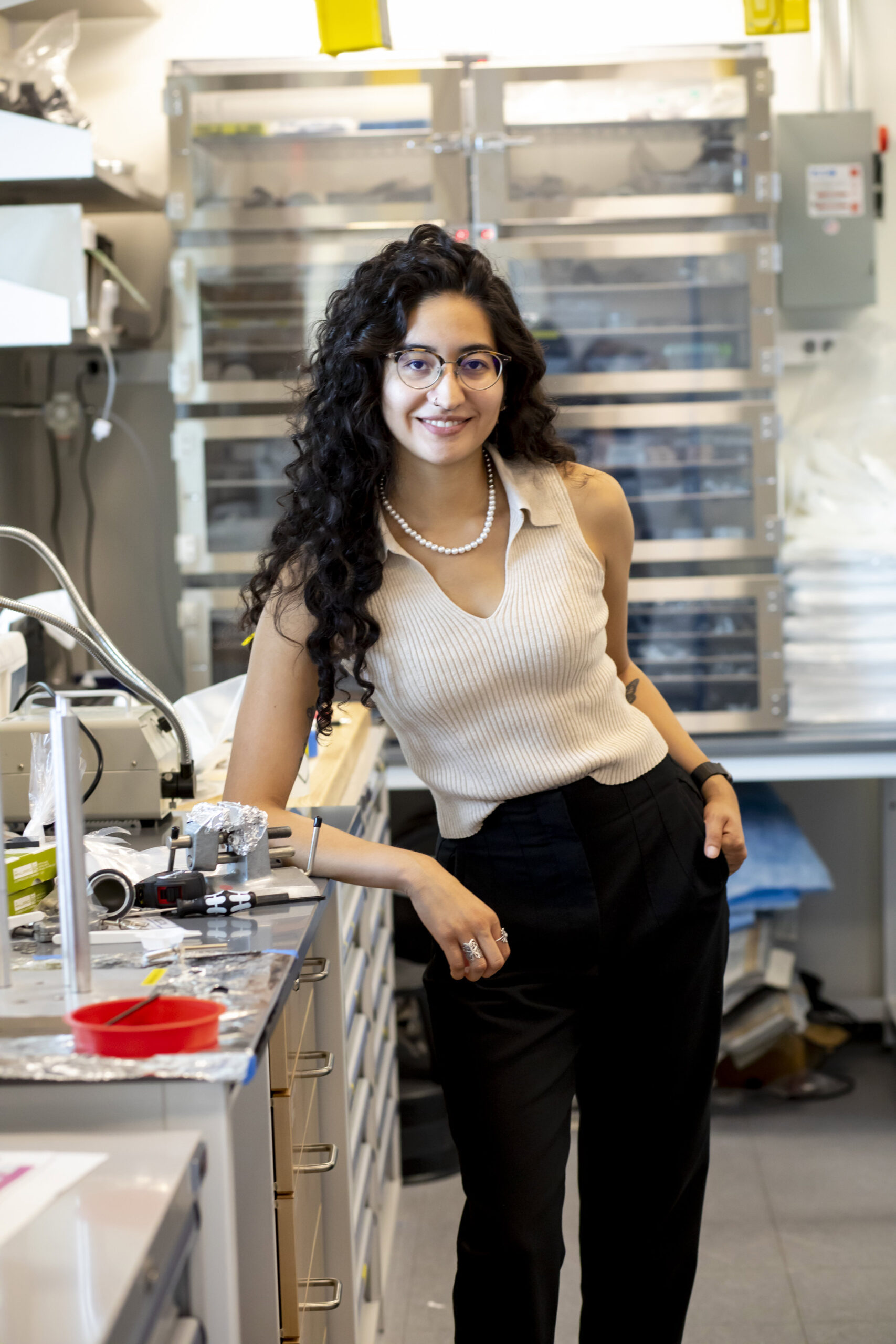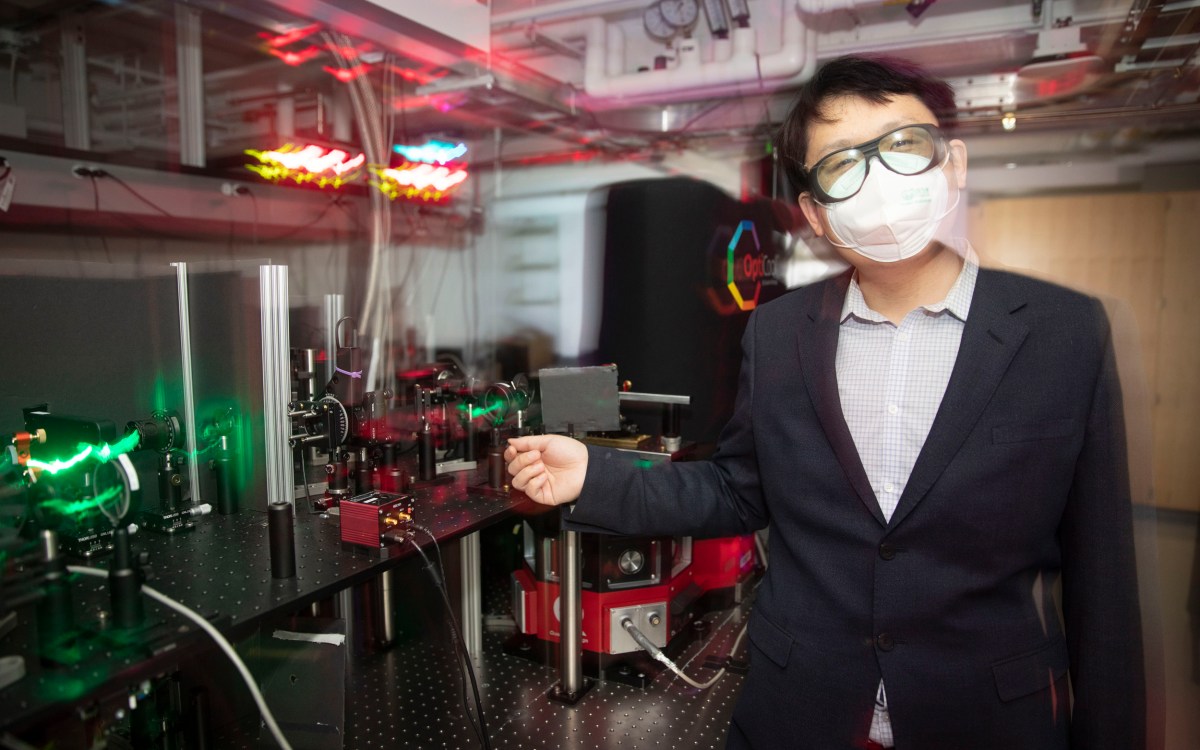
Andrew Winnicki, a rising senior studying physics and math, works with lasers in the Doyle Lab.
Rose Lincoln/Harvard Staff Photographer
Look at life in lab
Students lead research projects, sample day-to-day routine of working scientist in Quantum Initiative summer program
Denisse Córdova Carrizales spent her summer, quite literally, bringing the heat.
On a typical day Córdova Carrizales, who begins her senior year this fall, would arrive at the lab of condensed-matter physicist Julia Mundy at about 9 a.m. and don a white protective suit. The physics concentrator’s research involved working with chemical compounds heated in an oven to temperatures as high as 1,200 degrees Fahrenheit. Her job was to X-ray samples and perform electrical tests in a sealed container. If the material showed potential as a superconductor, she’d do further testing.
Córdova Carrizales was part of the first group of fellows in the Harvard Quantum Initiative’s Summer Research Program. The program, which is in its inaugural year, supported 10 undergraduate researchers from June to mid-August as they worked full-time in labs belonging to members of HQI.
The fellowship is designed for students with any level of prior research experience and provides advising and stipends to help them spend the summer in the Cambridge area. It also provides opportunities for the students to present their work and network with colleagues and peers. They work with supervising faculty and members of labs to design and pursue research projects in quantum science, including quantum information, systems, materials, and engineering.

“It helped me feel more confident about doing research,” rising senior Denisse Córdova Carrizales said of the summer program.
Rose Lincoln/Harvard Staff Photograher
The program offers the fellows a glimpse at the real-world lives of research scientists — and it’s not always as exciting as some might think. Córdova Carrizales says her process is repetitive and often nothing comes from the experiments, but it forces her to continually rethink and tweak what she’s doing. Fascinated, challenged, and “borderline addicted” to the work, she described the summer experience as giving her some technical expertise and a confidence boost as a scientist.
“This summer in general has made me realize that I really do enjoy research and do want to go on,” Córdova Carrizales said. “It helped me feel more confident about doing research. I’ve gotten to lead my own project. It has all made me feel very capable.”
“The program is about students getting the opportunity to work in a quantum lab just as a regular member of the lab, as if they were a graduate student or a postdoc,” said John Doyle, Henry B. Silsbee Professor of Physics, who co-directs HQI. “Having undergraduate students do actual work in a lab is crucial to their education and their professional development. What we’ve been able to do is provide a very easy on-ramp for our students to have this experience.”
HQI launched in 2018 with the aim of expanding research, development, and education in a rapidly expanding field that is key to future innovations and major technological advancement.
Creation of the undergraduate research program was largely spearheaded by Mundy, an HQI member and assistant professor of physics and applied physics. A Harvard College alumna, she knows firsthand the power of such experiences for undergraduates, especially in areas that build on prior lab work. Those experiences, she said, were critical in shaping her career as a researcher in quantum materials.
“The summer between junior and senior year was completely pivotal for me,” Mundy said. “It wasn’t the first research experience I had, but it was a really special one because it’s right when you’re thinking about going to grad school and what [line of research to focus on]. It’s really exciting to see a new generation of undergraduates have the same experiences.”
Students in this year’s program are working on a range of projects, from optimizing quantum technology to decoding errors in quantum computers to building lasers that can more easily cut materials such as graphene. Córdova Carrizales, for example, designed a project looking for a new family of materials that could lead to superconductors that can operate at higher temperatures. It’s a Holy Grail in condensed-matter physics because of the door they would open to long-term, sustainable electric energy.
Andrew Winnicki, a rising senior from Quincy House studying physics and math, is part of the Doyle lab. He is using a laser array to control a molecule that one day could be used as a qubit in quantum computers.
“It’s unpredictable and exciting, because sometimes the experiment will throw something at us that we need to figure out how to deal with,” Winnicki said. “I’ve added many new techniques to my experimental tool kit, like different laser and optics setups, or skills such as designing electronics and machining hardware that will go inside of the vacuum chambers. It’s all been a big part of my growth as a scientist.”
Mincheol Park — an international student from South Korea who has a joint concentration in chemistry, physics, and math — is working on the theoretical side of quantum science. The rising junior is trying to produce a protocol to implement error-correcting codes for quantum processors that exist today. He’s valued the mentorship working full-time in the lab of physicist Mikhail Lukin. Park said he’s learned a lot from graduate students in the lab about how to prioritize work and what to do when something isn’t working. It also helps to hear about their career paths.
“It’s really good that I am able to learn this kind of lifestyle this early after my second year of college,” Park said.
The HQI undergraduate fellowship hosts a series of lunches for the fellows to network with other fellows and learn about each other’s work, as well as unwind and bond over their shared summer experience. There is also a poster session where the students present their work to the larger HQI community.
“It was an unexpected community this summer,” said Cassia Lee, a rising junior in Eliot House concentrating in chemistry and physics. “It’s easy to focus on your work and be in your own bubble, but it was really good to take a step back and see what everyone is doing.”
Standing at the poster session amid the different projects and diverse group of students, Doyle reflected on another of the key points of the fellowship: students pushing themselves to their limits and beyond.
“Generally, students are able to rise to whatever level of capabilities they have,” Doyle said. “In the lab, there is no upper limit. They can go as far as they want.”








